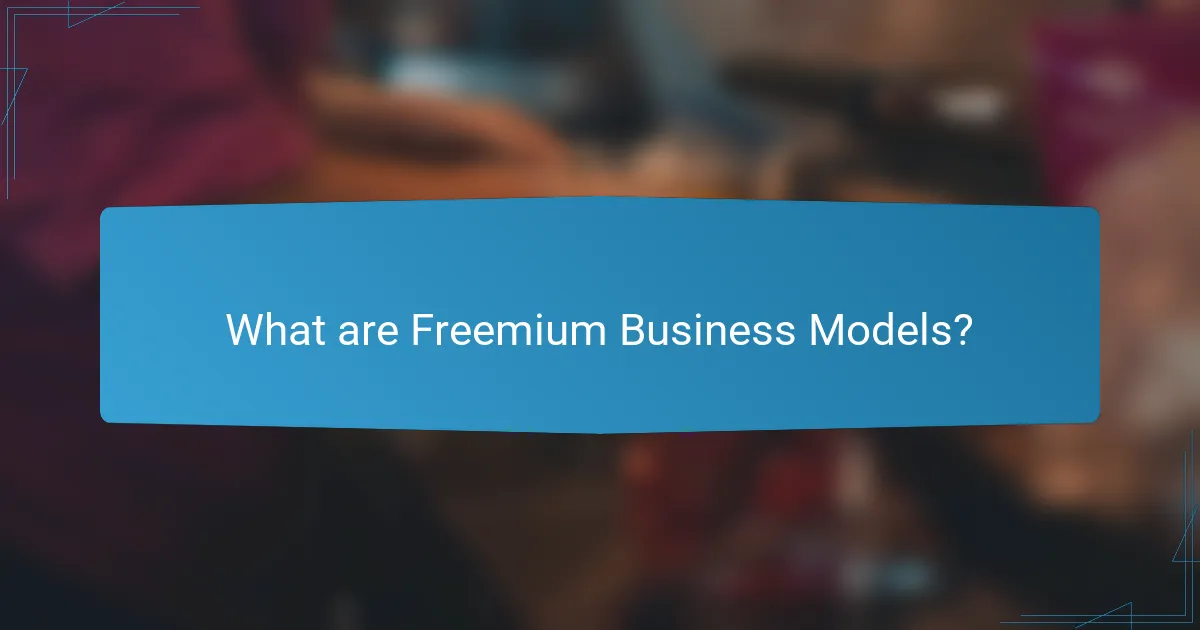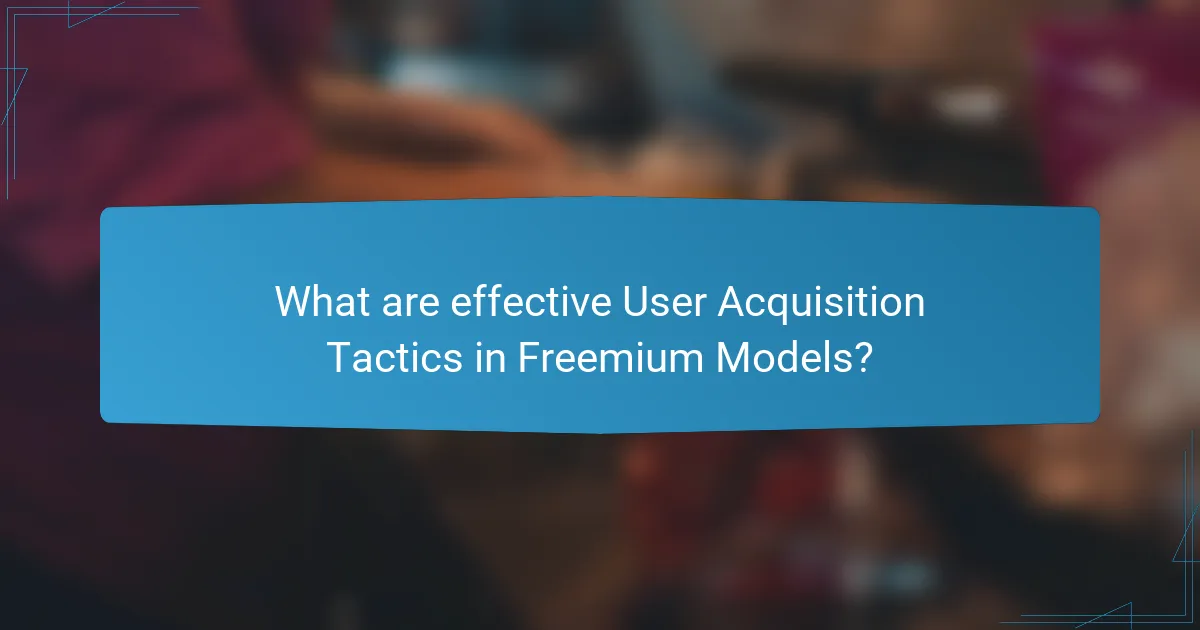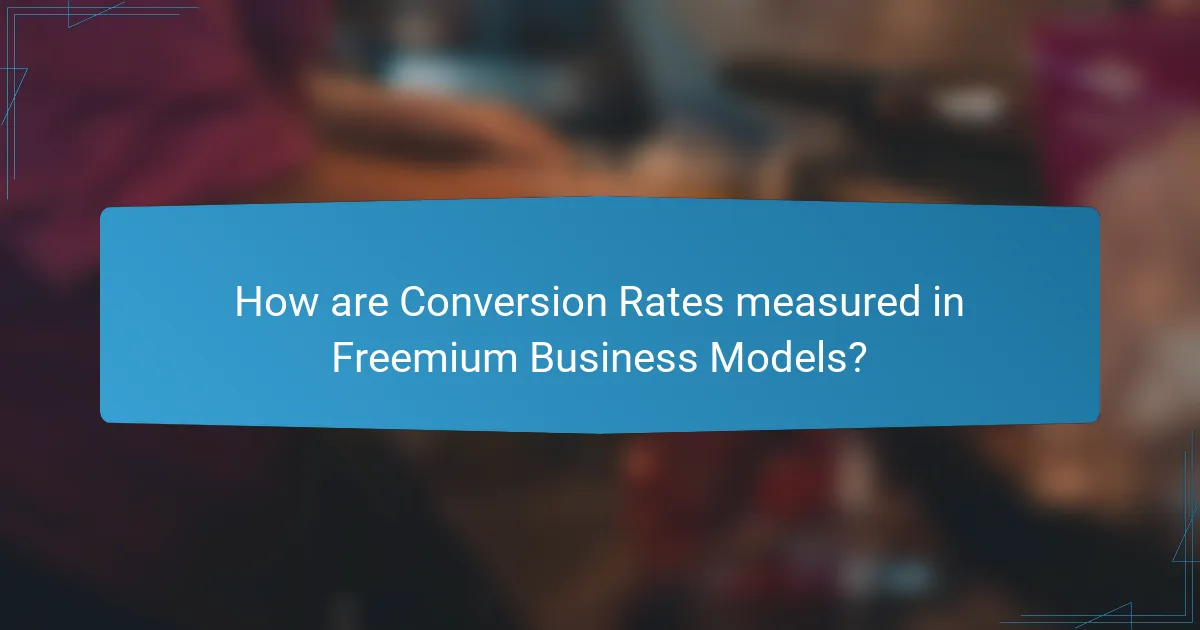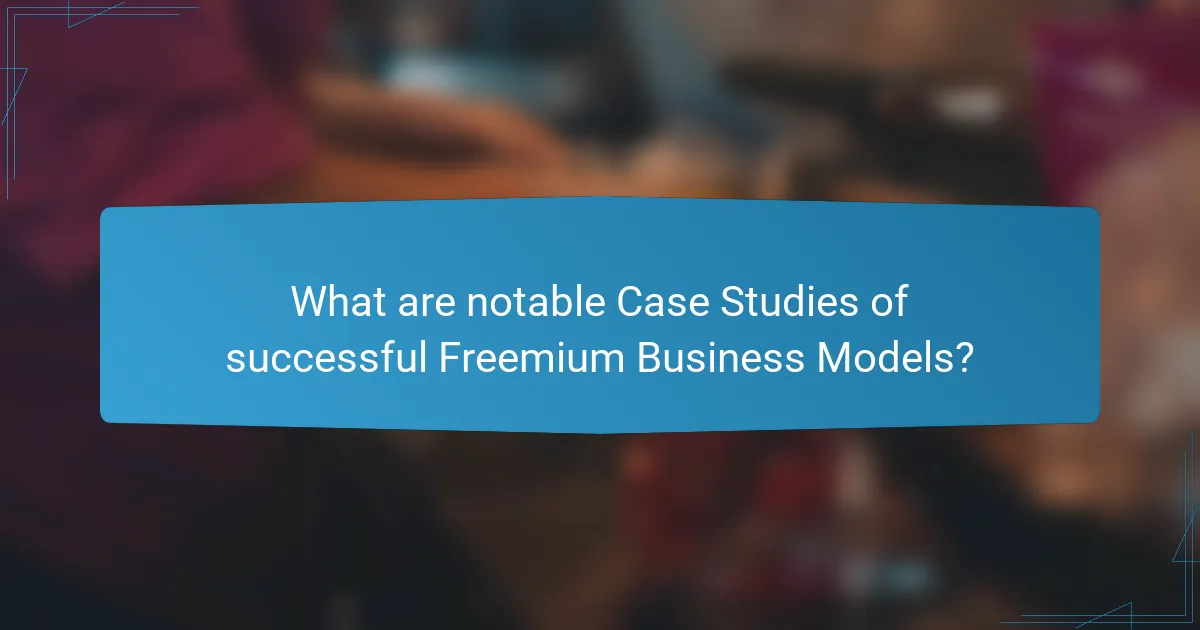Freemium business models provide basic services at no cost while charging for premium features, effectively lowering barriers to entry and fostering user engagement. This strategy aims to convert free users into paying customers over time, with companies like Spotify, Dropbox, and LinkedIn exemplifying successful implementations. Key tactics for user acquisition in these models include offering incentives, optimizing onboarding experiences, and utilizing social proof to enhance trust and credibility. Conversion rates, which measure the percentage of users transitioning from free to paid subscriptions, are critical for assessing the effectiveness of these models. The article will explore these user acquisition tactics, discuss conversion metrics, and highlight notable case studies that demonstrate the success of freemium strategies in driving user growth and revenue.

What are Freemium Business Models?
Freemium business models offer basic services for free while charging for premium features. This strategy attracts a large user base by removing initial barriers to entry. Users can experience the product without financial commitment. The goal is to convert free users into paying customers over time. Companies like Spotify and Dropbox successfully utilize this model. They provide essential functionalities for free, enhancing user engagement. Statistics show that a small percentage of users typically convert to paid plans. For instance, Dropbox reported a conversion rate of around 4%. This model leverages user acquisition and retention effectively.
How do Freemium Business Models differ from traditional models?
Freemium business models differ from traditional models primarily in their approach to customer acquisition. In a freemium model, basic services are offered for free, while premium features require payment. This contrasts with traditional models, where customers typically pay upfront for products or services.
Freemium models aim to attract a larger user base by lowering the entry barrier. This strategy can lead to a higher volume of users, increasing potential conversion rates to paid plans. Conversely, traditional models often rely on direct sales and may have a slower growth trajectory.
Evidence shows that companies like Spotify and Dropbox have successfully utilized freemium models to grow their user base significantly. For instance, Spotify reported 345 million active users, with 155 million paying subscribers as of 2021. This demonstrates the effectiveness of freemium strategies in converting free users to paying customers.
What are the key characteristics of Freemium Business Models?
Freemium business models are characterized by offering basic services free of charge while charging for premium features. This model attracts a large user base quickly. Users can experience the product before deciding to purchase upgrades. The conversion rate from free to paid users is crucial for profitability. Successful freemium models often include compelling premium features that enhance user experience. Examples include additional storage, advanced functionalities, or ad-free experiences. Data shows that companies like Dropbox and Spotify have effectively utilized this model. They convert a small percentage of free users into paying customers, which sustains their business.
Why are Freemium Business Models popular among startups?
Freemium business models are popular among startups because they lower the barrier to entry for users. This model allows potential customers to try a product or service for free. Startups can attract a larger user base quickly through this approach. Once users are engaged, they can be converted to paying customers over time. According to a study by Recurly, companies using freemium models see a 30% higher conversion rate than traditional models. This strategy also helps startups gather valuable user data. The data can be used to enhance product features and improve user experience. Overall, freemium models align well with the growth objectives of startups.
What types of Freemium Business Models exist?
There are several types of freemium business models. The most common types include the following:
1. **Basic Freemium**: Users access a limited version of the product for free. They can upgrade to a premium version for additional features.
2. **Time-limited Freemium**: Users can access the full product for a limited time. After the trial, they must pay to continue using it.
3. **Feature-limited Freemium**: Users get access to the product with certain features disabled. They can unlock these features by paying.
4. **User-based Freemium**: The model offers a free tier for a limited number of users. Additional users require a paid subscription.
5. **Service-based Freemium**: Users receive basic services for free, while advanced services come with a fee.
These models allow businesses to attract users while providing pathways to monetization. Each model has distinct advantages and suits different types of products.
How do tiered Freemium models function?
Tiered Freemium models function by offering multiple service levels, each with varying features and pricing. Users can access a basic version for free, which typically includes limited functionalities. As users find value, they may opt for higher tiers that unlock additional features, enhancements, or services. This model incentivizes users to upgrade by showcasing the benefits of premium offerings. Research indicates that 70% of freemium users never convert to paid plans, but tiered structures can improve conversion rates by appealing to diverse user needs. Companies like Spotify and Dropbox utilize tiered Freemium models effectively, demonstrating increased user engagement and revenue growth through this strategy.
What are the benefits of offering a free trial?
Offering a free trial increases user acquisition and engagement. It allows potential customers to experience the product risk-free. This encourages them to evaluate the product’s value before committing financially. According to a study by the SaaS company, 60% of users who try a product for free convert to paying customers. Free trials also help build trust and reduce buyer hesitation. Users can assess features and benefits firsthand. This leads to higher conversion rates compared to traditional marketing methods. Additionally, free trials can generate valuable user feedback for product improvement.

What are effective User Acquisition Tactics in Freemium Models?
Effective user acquisition tactics in freemium models include offering compelling incentives, optimizing onboarding experiences, and leveraging social proof. Incentives such as free trials or exclusive features encourage users to engage with the product. A seamless onboarding process helps users understand the product’s value quickly. Social proof, like user testimonials and case studies, builds trust and credibility. According to a study by AppsFlyer, apps with optimized onboarding see a 30% increase in user retention. These tactics collectively enhance user acquisition efforts in freemium models.
How can businesses attract users to their Freemium offerings?
Businesses can attract users to their Freemium offerings by providing clear value and engaging experiences. Highlighting unique features can differentiate the offering from competitors. Effective marketing strategies, such as targeted social media ads, can reach potential users. Offering limited-time promotions can create urgency and encourage sign-ups. User testimonials and case studies can build trust and credibility. Simplifying the onboarding process enhances user experience and retention. Regular updates and improvements keep users engaged and interested. According to a study by the Harvard Business Review, companies that emphasize user benefits see a 30% increase in user acquisition rates.
What role does marketing play in user acquisition for Freemium models?
Marketing is crucial in user acquisition for freemium models. It creates awareness and attracts users to the free offering. Effective marketing strategies include targeted advertising and social media engagement. These methods help reach potential users who may benefit from the product.
In 2020, a study showed that 60% of freemium users discovered the product through online ads. Content marketing also plays a significant role by providing valuable information that draws users in. Additionally, referral programs incentivize existing users to invite new ones.
This approach can lead to a 25% increase in user sign-ups. Overall, marketing drives the initial interest and user base growth for freemium models.
How can social media be leveraged for user acquisition?
Social media can be leveraged for user acquisition by utilizing targeted advertising and engaging content. Targeted ads allow businesses to reach specific demographics that align with their user base. Platforms like Facebook and Instagram offer advanced targeting options based on user behavior and interests. Engaging content, such as videos and interactive posts, can attract potential users and encourage sharing. According to a HubSpot report, 54% of social media users browse products on these platforms. This indicates a strong potential for user acquisition through social media channels. Additionally, utilizing influencers can expand reach and credibility, further driving user interest and acquisition.
What strategies enhance user engagement in Freemium models?
Effective strategies to enhance user engagement in Freemium models include personalized onboarding, regular updates, and community building. Personalized onboarding helps users understand the product’s value quickly. It can increase user retention by 50% according to studies. Regular updates keep users informed and engaged with new features. This strategy encourages users to explore the product further. Community building fosters user interaction and loyalty. Engaged users are 30% more likely to convert to paid plans. Offering exclusive content or features to active users also boosts engagement. This tactic can lead to a 20% increase in conversion rates.
How can onboarding processes improve user retention?
Onboarding processes can significantly improve user retention by enhancing user engagement and satisfaction. Effective onboarding provides users with a clear understanding of the product’s features and benefits. This clarity helps users feel more confident in using the product. Research shows that users who receive a structured onboarding experience are 50% more likely to remain active after the first week. Additionally, onboarding can reduce the learning curve associated with new software. When users are guided through initial tasks, they are less likely to feel overwhelmed. This support fosters a positive first impression, increasing the chances of long-term commitment.
What features encourage users to upgrade from free to paid plans?
Users are encouraged to upgrade from free to paid plans by features such as enhanced functionality, increased storage, and ad-free experiences. Enhanced functionality often includes advanced tools or capabilities not available in the free version. Increased storage allows users to save more data or files, which is appealing for heavy users. An ad-free experience improves user satisfaction by eliminating interruptions.
Additional features like priority customer support can also incentivize users to upgrade. Users appreciate faster response times and dedicated assistance. Exclusive content or features, such as premium templates or advanced analytics, can further entice users.
According to a study by ProfitWell, 70% of users are more likely to upgrade if they see clear value in premium features. This demonstrates that tangible benefits significantly influence user decisions to transition from free to paid plans.

How are Conversion Rates measured in Freemium Business Models?
Conversion rates in freemium business models are measured by the percentage of users who transition from free to paid subscriptions. This metric is calculated by dividing the number of paying users by the total number of users, then multiplying by 100. For example, if a service has 1,000 total users and 50 of them convert to paid plans, the conversion rate is 5%.
Tracking tools like Google Analytics can help in gathering this data. Additionally, businesses often analyze user behavior to identify patterns leading to conversions. Understanding these patterns can enhance marketing strategies and improve conversion rates over time.
What factors influence conversion rates in Freemium models?
Conversion rates in freemium models are influenced by several key factors. User experience plays a crucial role; a seamless onboarding process increases user engagement. The perceived value of premium features significantly impacts conversion; users must see clear benefits to upgrade. Pricing strategies also affect conversion rates; competitive and transparent pricing can drive more users to convert. Marketing efforts, such as targeted promotions, can enhance visibility of premium offerings. Additionally, user retention strategies, including regular updates and customer support, help maintain interest in upgrading. Data from a 2020 study by Reforge indicates that companies with effective onboarding see conversion rates increase by up to 30%.
How can businesses analyze user behavior to improve conversion rates?
Businesses can analyze user behavior through various methods to improve conversion rates. They can utilize web analytics tools to track user interactions on their platforms. These tools provide insights into user navigation patterns and behavior. Heatmaps can visually represent where users click and scroll the most. A/B testing allows businesses to compare different versions of web pages. This helps identify which design or content performs better. User feedback through surveys can reveal pain points in the user experience. Additionally, session recordings can show how users interact in real-time. According to a study by HubSpot, companies that analyze user behavior see a 30% increase in conversion rates. By implementing these strategies, businesses can make informed decisions that enhance user engagement and ultimately drive conversions.
What metrics should be tracked to measure success?
Key metrics to track for measuring success in freemium business models include user acquisition cost, conversion rate, and customer lifetime value. User acquisition cost measures the total expense incurred to acquire a new user. This metric helps assess the efficiency of marketing efforts. Conversion rate indicates the percentage of users who upgrade from the free version to a paid plan. A higher conversion rate signifies effective value communication. Customer lifetime value estimates the total revenue generated from a customer during their relationship with the business. This metric is crucial for understanding long-term profitability. Additionally, tracking churn rate is important as it shows the percentage of users who stop using the service. Monitoring engagement metrics, such as daily active users, can provide insights into user retention and satisfaction. These metrics collectively inform strategy adjustments and resource allocation for maximizing success.
How do pricing strategies affect conversion rates?
Pricing strategies significantly influence conversion rates. Effective pricing can attract potential customers and encourage them to complete purchases. For instance, offering a freemium model allows users to experience a product at no cost, increasing initial sign-ups. Research shows that 20% of freemium users convert to paid plans after experiencing value. Competitive pricing can also create a sense of urgency, prompting quicker purchasing decisions. Additionally, tiered pricing structures cater to diverse customer segments, enhancing overall conversion potential. A study by Harvard Business Review indicates that businesses with clear pricing strategies see a 30% increase in conversion rates.
What are the advantages of offering multiple pricing tiers?
Offering multiple pricing tiers increases accessibility for a broader audience. Different tiers cater to varying budgets and needs. This approach attracts both price-sensitive customers and those willing to pay more for premium features. It enhances user acquisition by providing options that fit different financial situations. According to a study by McKinsey, companies with tiered pricing can see a 20-30% increase in conversion rates. Additionally, multiple tiers can lead to upselling opportunities as users may start at a lower tier and upgrade over time. This strategy also allows businesses to segment their offerings, improving customer satisfaction by aligning features with specific user needs.
How can discounts and promotions drive conversions?
Discounts and promotions can significantly drive conversions by creating a sense of urgency and value. When customers perceive a limited-time offer, they are more likely to make a purchase. Promotions can also lower the perceived risk of trying a new product or service. Research shows that 70% of consumers are more likely to purchase a product on sale. This increase in likelihood translates directly to higher conversion rates. Additionally, discounts can attract new customers who may not have considered the product at full price. The effectiveness of promotions is supported by data indicating that 60% of shoppers will abandon their cart if a discount is not available.

What are notable Case Studies of successful Freemium Business Models?
Notable case studies of successful freemium business models include Spotify, Dropbox, and LinkedIn. Spotify offers a free tier with ads and a premium subscription without ads. This model has allowed Spotify to amass over 400 million users, with 180 million paying subscribers as of 2023. Dropbox provides free storage space, encouraging users to upgrade for more space and features. This strategy helped Dropbox reach over 700 million users, with significant revenue from premium subscriptions. LinkedIn offers free access to basic networking features, while premium subscriptions provide advanced tools for job seekers and recruiters. LinkedIn has over 900 million members, with strong revenue from its premium services. These examples illustrate the effectiveness of freemium models in user acquisition and monetization.
What lessons can be learned from successful Freemium companies?
Successful Freemium companies demonstrate key lessons in user acquisition and conversion strategies. First, they effectively balance free and premium features. This balance encourages users to engage with the product without overwhelming them. Second, they utilize data analytics to understand user behavior. This insight allows for targeted marketing efforts and feature enhancements. Third, successful companies create a clear value proposition for premium offerings. Users must see significant benefits to justify upgrading. Fourth, they foster community and user engagement. This builds loyalty and encourages word-of-mouth referrals. Lastly, they often implement A/B testing for optimization. This method helps refine user experience and conversion tactics. These strategies collectively enhance user retention and increase conversion rates.
How did Dropbox utilize Freemium strategies to grow its user base?
Dropbox utilized Freemium strategies by offering free storage space to attract users. This initial free offering encouraged sign-ups and allowed users to experience the service without cost. Dropbox provided 2 GB of free storage, which was appealing to potential users. The company incentivized users to refer friends by offering additional free space for each successful referral. This referral program significantly boosted user acquisition. As a result, Dropbox grew from 100,000 users to over 4 million in just 15 months. The Freemium model effectively converted free users to paid plans as their storage needs increased.
What role did Spotify’s Freemium model play in its market [censured]?
Spotify’s Freemium model significantly enhanced its market [censured]. This model allowed users to access a basic version of the service for free. As a result, Spotify attracted millions of users quickly. The free tier provided exposure to a large audience, increasing brand awareness. Users could experience the platform without financial commitment. This strategy encouraged upgrades to paid subscriptions over time. In 2021, Spotify reported over 158 million premium subscribers, showcasing conversion success. The Freemium model effectively balanced user acquisition and revenue generation.
What challenges do Freemium models face?
Freemium models face several challenges that can impact their success. One significant challenge is user conversion. A large percentage of users may remain on the free tier without upgrading. Research indicates that conversion rates often hover around 2-5%. Another challenge is monetization. Relying solely on a small percentage of paying users can lead to financial instability. Additionally, competition in the market can dilute user attention. Many alternatives may offer similar free services, making user retention difficult. Finally, maintaining user engagement is crucial. If users do not find ongoing value in the product, they may disengage. These challenges highlight the complexity of sustaining a freemium business model.
How can companies overcome common pitfalls in Freemium strategies?
Companies can overcome common pitfalls in Freemium strategies by ensuring clear value differentiation between free and premium offerings. This clarity helps users understand the benefits of upgrading. Additionally, companies should focus on user engagement and retention to maintain interest in the product. Regularly updating features and providing excellent customer support can enhance user experience.
Another strategy involves targeted communication to guide users toward premium plans. Data analytics can help identify user behavior and preferences, allowing for tailored marketing efforts. Companies should also avoid feature overload in free versions, which can confuse users. Instead, they should highlight key functionalities that entice users to convert.
Research indicates that 2-5% of freemium users typically convert to paid plans. Therefore, optimizing the conversion funnel is crucial for maximizing revenue potential. By implementing these strategies, companies can effectively mitigate risks associated with Freemium models.
What are the risks of relying too heavily on a Freemium model?
Relying too heavily on a Freemium model can lead to significant risks. One major risk is low conversion rates from free to paid users. Studies show that only about 2-5% of freemium users typically convert to paying customers. This can result in insufficient revenue to sustain the business.
Additionally, a freemium model may attract users who are not genuinely interested in the product. These users may engage with the service but contribute little to no revenue. This can inflate user metrics without providing financial benefits.
Another risk involves the potential degradation of service quality. Companies may struggle to maintain features and support for free users while trying to monetize the premium tier. If free users experience poor service, it can damage the brand’s reputation.
Lastly, over-reliance on a freemium model can lead to increased competition. Many businesses adopt similar strategies, making it challenging to differentiate and retain users. This saturation can further depress conversion rates and profitability.
What best practices can enhance the effectiveness of Freemium Business Models?
To enhance the effectiveness of Freemium Business Models, companies should focus on user experience, targeted marketing, and clear value propositions. A seamless onboarding process increases user retention. Providing valuable features in the free tier encourages users to engage. Targeted marketing campaigns can attract specific user demographics. Clear communication of premium benefits can drive conversions. Regular updates and improvements to the product maintain user interest. Data analytics help in understanding user behavior and optimizing features. According to a study by the Harvard Business Review, effective user engagement strategies can increase conversion rates significantly.
Freemium business models provide basic services at no cost while charging for premium features, aiming to convert free users into paying customers. This article explores the differences between freemium and traditional business models, key characteristics, and various types of freemium strategies. It also highlights effective user acquisition tactics, the role of marketing, and methods to enhance user engagement and conversion rates. Notable case studies, including Spotify and Dropbox, illustrate successful implementations of freemium models, while addressing common challenges and best practices for optimizing these strategies.